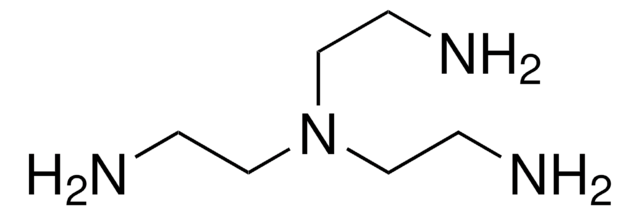408719
Polyethylenimine, branched
average Mw ~800 by LS, average Mn ~600 by GPC
Synonim(y):
PEI, ethylenediamine branched
About This Item
Polecane produkty
Postać
viscous liquid
masa cząsteczkowa
average Mn ~600 by GPC
average Mw ~800 by LS
współczynnik refrakcji
n20/D 1.5240
gęstość
1.050 g/mL at 25 °C
InChI
1S/C2H8N2.C2H5N/c3-1-2-4;1-2-3-1/h1-4H2;3H,1-2H2
Klucz InChI
SFLOAOINZSFFAE-UHFFFAOYSA-N
Powiązane kategorie
Opis ogólny
Zastosowanie
Bamboo charcoal impregnated with PEI can be used as a CO2 adsorbent. Numerous amino groups present in PEI can react with CO2 due to acid-alkali interaction and enhance the adsorption capacity of bamboo charcoal.
It can also be used to prepare cross-linked water-soluble polymers with high coordination capabilities towards organic drug molecules.
Cechy i korzyści
- Branched PEI has better complexation and buffering capacity.
- High ion exchange capacity and affinity toward proteins.
- SignificantDNA transfer efficiency.
Postać fizyczna
Hasło ostrzegawcze
Danger
Zwroty wskazujące rodzaj zagrożenia
Zwroty wskazujące środki ostrożności
Klasyfikacja zagrożeń
Acute Tox. 4 Oral - Aquatic Chronic 2 - Eye Dam. 1
Kod klasy składowania
10 - Combustible liquids
Klasa zagrożenia wodnego (WGK)
WGK 3
Temperatura zapłonu (°F)
356.0 °F
Temperatura zapłonu (°C)
180 °C
Środki ochrony indywidualnej
Eyeshields, Faceshields, Gloves, type ABEK (EN14387) respirator filter
Certyfikaty analizy (CoA)
Poszukaj Certyfikaty analizy (CoA), wpisując numer partii/serii produktów. Numery serii i partii można znaleźć na etykiecie produktu po słowach „seria” lub „partia”.
Masz już ten produkt?
Dokumenty związane z niedawno zakupionymi produktami zostały zamieszczone w Bibliotece dokumentów.
Klienci oglądali również te produkty
Produkty
Terapia genowa stała się jedną z najczęściej dyskutowanych technik w badaniach biomedycznych w ostatnich latach.
Gene therapy has become one of the most discussed techniques in biomedical research in recent years.
Professor Yoshiki Katayama (Kyushu University, Japan) discusses recent advances in drug delivery systems and strategies that exploit the EPR effect, with a special focus on stimuli-responsive systems based on novel materials.
We present an article that discusses two applications in particular; first, using these layers as polyelectrolyte membranes to control permeability.
Nasz zespół naukowców ma doświadczenie we wszystkich obszarach badań, w tym w naukach przyrodniczych, materiałoznawstwie, syntezie chemicznej, chromatografii, analityce i wielu innych dziedzinach.
Skontaktuj się z zespołem ds. pomocy technicznej







